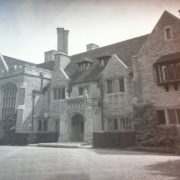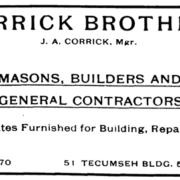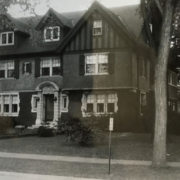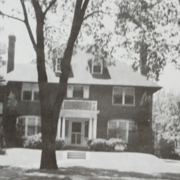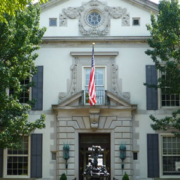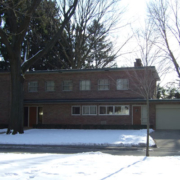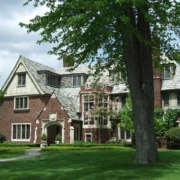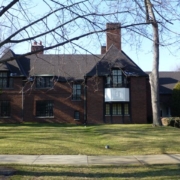Historical Architecture of Grosse Pointe – The Lost Tudor Mansions of Grosse Pointe – Part 1: the Standish Backus Estate
After the conclusion of World War 1 the number of mansions in Grosse Pointe grew exponentially. The construction of grand homes for wealthy occupants was visible throughout the community, non more so than on Lake Shore.
Wealthy Detroiter’s were choosing to utilize their prosperity and fortunes by commissioning the architectural crème de la crème to create a one of a kind grandiose mansions for their families.
Arguably some of the most famous homes constructed during this era were the Harley Higbie House (1926), the Roy D. Chapin home (1927), Rose Terrace (1934), the Alvan Macauley Home (1930), the Edsel B. Ford Estate (1929) and the Standish Backus Mansion (1934).
While the majority of these homes have now gone, they are not forgotten. We have already covered several of these homes, and now its time to turn our attention to one of the lost Tudor Mansions – 725 Lakeshore – also known as the Standish Backus Mansion.
The Standish Backus residence was one of Grosse Pointe’s grandest homes. Commissioned by Standish Backus in 1934, Mr. Backus was a lawyer, engineer, general Counsel for General Motors (in 1911) and became President of the Burroughs Adding Machine Company in 1920. The home was situated on a 12-acre estate – once the property of Dudley Woodbridge, son of Michigan’s second governor.
This large estate was as grand as they come. Aside from being a prime example of a Tudor mansion, this property was also noted for its exquisite gardens. Research from the book Tonnancour describes the home accordingly – ‘to enter the Backus estate is to transport oneself back to sixteenth century England’.
The House
Ralph Adams Cram (a friend of Standish Backus) designed the house in association with local architect Robert O. Derrick. Cram has been described as a ‘prolific and influential American architect of collegiate and ecclesiastical buildings’. Born in New Hampshire in 1863, Cram spent most of his career in Boston. Early on in his career he partnered with Charles Wentworth, before being joined by Bertram Goodhue in 1892. They focused primarily on church commissions, working throughout the United States, Cram was best known for his Gothic Revival Style. Prior to designing the mansion for Mr. Backus it is believed Cram’s only other commission in the area was the Cathedral of St. Paul, Detroit, 1908.
Cram’s residential work, including the Backus home, was primarily in the Tudor style, and heavily influence by Gothic origins. The stone façade, prominent chimneys, mullioned Tudor windows and grand carved entrance are classic traits of an English Country Manor home. Based on research from the book ‘Fletcher Steele, Landscape Architect’ (By Robin S. Karson) Backus was a huge fan of early English architecture, and it was his desire the house was designed in this style. No expense was spared in creating the 40-room residence; the house was finished with beautiful wood paneling, fine mantels and friezes. The home also featured an 8-car garage with electric doors, a telephone system to connect all the rooms, and a walk-in vault to protect the families silver service.
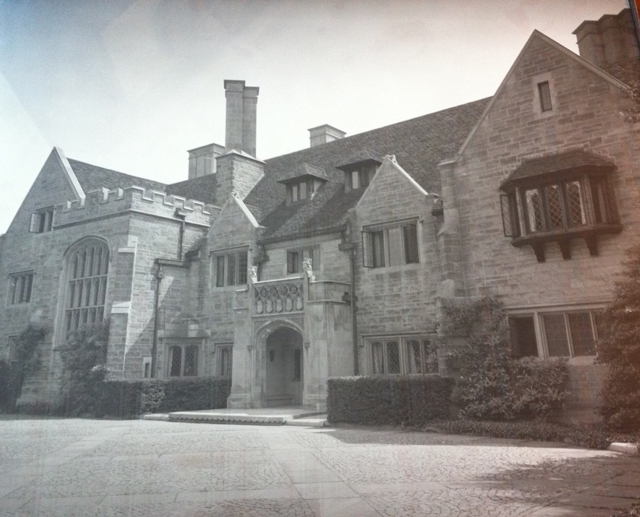
The Garden
Not to be outshone the garden was equally as impressive, if not more so. A phenomenal landscape architect – Fletcher Steel – designed the garden. Steele is credited with designing over 700 gardens in the United States from 1915 until his death in 1971.

Standish Backus and Fletcher Steele – 1933 – courtesy of www.esf.edu/moonlib/steele/
It is believed Steele was introduced to Backus through Ralph Cram, in what would be a 10-year project to complete the garden at the Backus estate. The fascinating full story of this garden can be found here – ‘Fletcher Steele, Landscape Architect’ (By Robin S. Karson) – courtesy of Google books – most of the following research and photo’s are excerpts from this book.
The design of the garden involved a great deal of plans and drawings. Steele collaborated with Cram closely to ensure the garden worked in harmony with the design of the house. Steele originally was asked to create a design for 5 acres, but the purchase of an additional 7 acres dramatically increase his project. Standish Backus and his wife, Lotta Boyer Backus, a keen gardener – were heavily involved with the design of the garden, focusing heavily on architected features as opposed to the plants.

Front lawn and view to Lake-St. Clair – Courtesy of: www.esf.edu/moonlib/steele/

View towards the house – Courtesy of: www.esf.edu/moonlib/steele/

Stone Garden Seat – Courtesy of: www.esf.edu/moonlib/steele/
The formal garden included sweeping lawns, a large pond, and numerous Baroque architectural features. Steele was very creative in the use of large box bushes, and rows of clipped European beech and linden trees. Steele approached the design of the garden by creating sections. Each section used architectural elements and plants to define the area, with the sections fitting together ‘like an ingenious jigsaw puzzle’.

Stone Tracery with section of lilacs – Courtesy of: www.esf.edu/moonlib/steele/

Forecourt with a thyme bed and an obelisk – Courtesy of: www.esf.edu/moonlib/steele/
The book notes ‘the Detroit News reported the Backus house cost nearly $1 million (roughly $18m today). The tulip bill for one of the twelve flower gardens on the estate one-year came to $328.48 (around $6,000 today) it bought 5,300 bulbs’.
The Standish Backus mansion was a one of a kind residence. It was sold to Horace C. Ford in 1966 and like many mansions of this era was demolished (also in 1966) with the land being divided into several sub divisions, now known as “Stratton Place”.
We will continue the story on the Lost Tudor Mansions of Grosse Pointe next week with Part 2: the Alvan Macauley house.
*Photos courtesy of the Higbie Maxon Agney archives unless stated.
Written by Katie Doelle
Copyright © 2016 Katie Doelle

